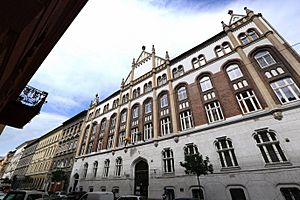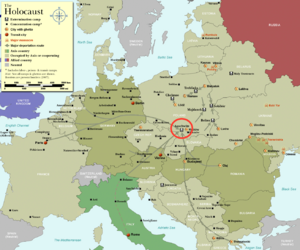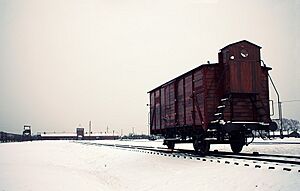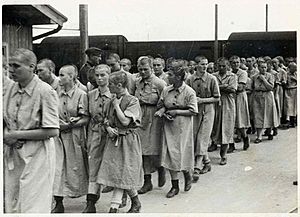Jane Haining facts for kids
Quick facts for kids
Jane Haining
|
|
|---|---|
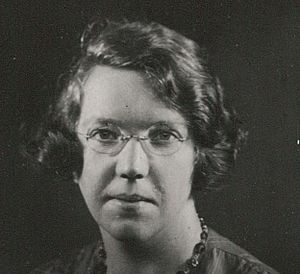 |
|
| Born | 6 June 1897 Dunscore, Scotland
|
| Died | 17 July 1944 (aged 47) Auschwitz II-Birkenau, German-occupied Poland
|
| Cause of death | Unknown |
| Occupation | Christian missionary in Hungary |
| Years active | 1932–1944 |
| Employer | Church of Scotland |
| Parent(s) |
|
| Awards |
|
Jane Mathison Haining (born June 6, 1897 – died July 17, 1944) was a brave Scottish missionary. She worked for the Church of Scotland in Budapest, Hungary. In 1997, she was honored by Yad Vashem in Israel as Righteous Among the Nations. This award is given to non-Jewish people who risked their lives to help Jews during the Holocaust.
Jane Haining worked in Budapest starting in June 1932. She was the matron, or supervisor, of a boarding house for girls. These girls were both Jewish and Christian. The boarding house was part of a school run by the Scottish Mission to the Jews. After World War II began in 1939, the Church of Scotland told Jane to go back to Britain. But she chose to stay in Hungary.
In March 1944, Nazi Germany invaded Hungary. The SS, a powerful Nazi group, began sending Jewish people from Hungary to Auschwitz II-Birkenau. This was a German extermination camp in occupied Poland. Jane Haining was arrested by the Gestapo (German secret police) in April 1944. She was then sent to Auschwitz-Birkenau in May. She died there two months later, likely because of the terrible conditions in the camp.
Contents
Jane's Early Life and School
Jane Haining was born on a farm in Dunscore, Scotland. She was the fifth of six children. Her mother died when Jane was about five years old. Jane grew up in the Craig Church in Dunscore.
She went to Dunscore village school. In 1909, she won a scholarship to Dumfries Academy. This meant she could go to a better school. She lived there as a boarder, which means she lived at the school. Jane was a very good student. She won many school prizes and graduated with high marks in English, French, German, Latin, and Math.
Becoming a Missionary
After school, Jane trained at the Athenaeum Commercial College in Glasgow. From 1917 to 1927, she worked for a thread company called J. & P. Coats Ltd. She started as a clerk and later became a secretary. During this time, she lived in Glasgow and taught at a Sunday School.
It was around this time that Jane became interested in becoming a missionary. Missionaries are people who travel to spread their religious beliefs and help others. In 1927, she went to a meeting about missionary work. She reportedly told a friend, "I have found my lifework!"
Jane then took a course in domestic science and housekeeping. She worked for a short time in Glasgow and Manchester. In 1932, she saw an advertisement in a church magazine. The Church of Scotland was looking for a matron for a girls' hostel in Budapest, Hungary. Jane applied for the job.
Working at the Scottish Mission
The Scottish Mission in Budapest had a school for both Jewish and Christian girls. The Church of Scotland had started this mission in 1841. Its goal was to share Christianity with Hungarian Jews.
Jane Haining received more training for her new role. Her special service took place in Edinburgh on June 19, 1932. She left for Budapest the very next day. This was seven months before Adolf Hitler became the leader of Germany.
The girls' home was on the third floor of the mission building. In 1932, it had two bedrooms, each with about 16 girls. Most of the students were Jewish. Jane wrote that the school had 400 students in total, from ages six to 16. About 30-40 of these girls lived at the mission or came for the day. Jane was in charge of these girls.
The school taught the girls about the New Testament every day. Jane also worked to create club rooms for girls who had left the school. This way, they could continue to learn and be part of the mission.
World War II and Difficult Choices
When World War II started on September 3, 1939, Jane Haining was on holiday. She returned to Budapest right away. In 1940, the Church of Scotland advised her to go back to Scotland. But Jane felt safe in Hungary and decided to stay.
She wrote to someone, "The children are gradually getting into harness and I am having time to miss the letters which do not come." She also mentioned that Hungary was neutral and wanted to stay out of the war.
As the war continued, Jewish refugees from all over Europe came to Hungary. They were trying to escape the Holocaust. Jane Haining worked hard to find food for the girls' home. She would wake up early on market days and carry heavy bags of food herself. She even cut up her leather suitcase to fix the girls' shoes.
One former student said that they felt safe and protected at the mission. They knew they were treated equally there. The mission staff also helped Jewish refugees try to get to safety in other countries. Jane Haining even taught classes to Jewish refugees about life in Britain.
German Invasion and Arrest
On March 19, 1944, Germany invaded Hungary. The SS immediately began to send Jewish people to Auschwitz. Adolf Eichmann, a high-ranking Nazi officer, came to Budapest to manage these deportations.
New rules were put in place for Jewish people. They could not own cars or radios. They could not use telephones or public places like swimming pools. They had to declare all their property. Jewish lawyers and journalists were fired. Jewish people over six years old had to wear a yellow Star of David badge on their clothes. If the star was the wrong size, they could be arrested.
In mid-April 1944, the SS began gathering Jewish people into holding areas. These included ghettos and brick factories. People were held there for weeks with very little food.
In late April or early May 1944, two Gestapo officers came to the mission home to arrest Jane Haining. They searched her office and bedroom. They gave her only 15 minutes to pack. A colleague wrote in her diary that Jane was accused of having a secret radio.
Jane was first held in a Gestapo house, then moved to a prison. Her friends brought her food and clean clothes every week. A fellow prisoner, Miss Francis W. Lee, later said that Jane was questioned twice. She was accused of several things:
- Working with Jewish people.
- Crying when putting yellow stars on the girls.
- Firing her housekeeper, who was not Jewish.
- Listening to news from the BBC (a British radio station).
- Having many British visitors.
- Being involved in politics.
- Visiting British prisoners of war.
- Sending parcels to prisoners of war.
Jane admitted to most of the charges, except being involved in politics. She said she was too busy. She was then moved to a transit camp called Kistarcsa. Her friends tried to bring her food, but she was already gone. Francis Lee wrote that Jane laughed about the charges. She said she felt "stupid" repeating "Yes, it is true" after each one. But she cried when she admitted to weeping over the yellow stars.
Bishop László Ravasz of the Hungarian Reformed Church tried to help Jane. He spoke to the leader of Hungary, Admiral Miklós Horthy. The Admiral was sad to hear about Jane's arrest. Bishop Ravasz also spoke to the Prime Minister. He asked them to help release Jane, but he never received a reply.
Deportation to Auschwitz
In April 1944, the Germans began sending Hungary's Jews to Auschwitz II-Birkenau. The mass transports started on May 15. Between then and July 9, 1944, the SS sent Jewish people in closed goods wagons. About 12,000 people were sent each day. Over 437,000 Hungarian Jews were deported.
The journey was terrible. People were squeezed into the wagons in horrible conditions. There was little air, light, food, or water. Many people died during the journey. One survivor, Gertrud "Trude" Levi, described how 120 people were put into trucks meant for 60-90. She said, "people went into hysterics, people went mad, people had heart attacks, and people died."
From May 1944, trains arrived directly at Auschwitz II. The tracks led right to the gas chambers. The crematoria, where bodies were burned, could barely keep up. About 90 percent of the Hungarian Jews who arrived at Auschwitz were sent to the gas chambers right away. The others were chosen for forced labor.
Jane's Last Days
Jane Haining was sent to Auschwitz II on May 15, 1944. She was chosen for work, not the gas chamber. She was given the serial number 79467. This number was probably tattooed on her arm.
She sent a postcard from Auschwitz to Margit Prém, a friend at the mission school. The card was dated July 15, 1944. It was written in pencil and in German. On the card, Jane asked for apples, fresh fruit, biscuits, and other kinds of bread. She signed it "Your loving Jean."
According to a death certificate, Jane Haining died in a hospital in Auschwitz on July 17, 1944. This was just two days after she wrote her postcard. The certificate said she died of "cachexia following intestinal catarrh." This means she died from extreme weakness and wasting away, likely due to starvation and disease.
Bishop Ravasz later wrote that the Hungarian Reformed Church deeply respected Jane. He said her superiors had asked her three times to go home, but she always refused.
After the war, Jane Haining's Bible was found in the mission home. It is now on display there. In 2016, some of her belongings were found in Edinburgh. These included her handwritten will and over 70 photos of the girls from the mission school. These items are now in the National Library of Scotland.
Remembering Jane Haining

In 1946, a memorial tablet for Jane Haining was placed at the Scottish Mission in Budapest. In June 1948, two stained glass windows were put in her honor in a church in Glasgow where she used to worship.
On January 27, 1997, International Holocaust Remembrance Day, Jane Haining was recognized as Righteous Among the Nations by Yad Vashem. Her name is written on a wall of honor in the Garden of the Righteous in Jerusalem. This award honors non-Jewish people who risked their lives to save Jews during the Holocaust. Jane Haining was the second Scot to receive this honor.
Other memorials to Jane Haining include:
- A stone cairn near Dunscore Church, built in 2005.
- A Church of Scotland "Jane Haining prize." This prize arranges for a Hungarian teacher and two students to visit Scotland each year.
- In 2010, a part of an embankment along the Danube river in Budapest was renamed Jane Haining rakpart (Jane Haining quay).
- Also in 2010, the British government named her a British Hero of the Holocaust.
In 2016, a memorial event was held in Hungary. Former students of the mission school attended. In 2017, Jane was honored again in a new exhibition at the Holocaust Memorial Centre in Budapest.
Many artists have created works about Jane Haining. The Scottish singer-songwriter Karine Polwart wrote a song about her called "Baleerie Baloo." Raymond Raszkowski Ross wrote a play about her life called A Promised Land. A New Zealand journalist, Lynley Smith, wrote a fictional diary based on Jane's life.
On June 10, 2021, the Scottish Episcopal Church voted to include Jane Haining in its calendar of saints and heroes. She will be remembered on July 17 each year.
Images for kids
See also
- List of Righteous Among the Nations by country
- Eric Liddell - Scottish Olympic Gold medal winner and Christian missionary who died in a Japanese Prison Camp in China in 1945



